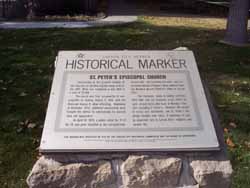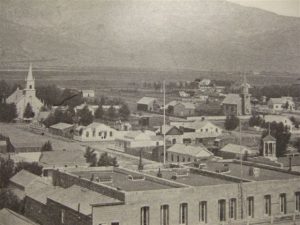St. Peter’s Episcopal Church in Carson City, Nevada, is unique in several respects. It began as an organized Parish on Monday, November 9, 1863, and was incorporated as such under the Nevada Territorial Government. (The Articles of Incorporation are recorded in the Ormsby County Recorders Office, not in that of the Secretary of State). It was incorporated under the title “The Rector and Wardens and Vestrymen of St. Peter’s Church and Parish.” Except for a period of about 35 years, (1920 to 1957) during which it received help from the National Church’s Missionary Society as an “Aided Parish;” it has been a Parish since its foundation. This is significant because practically all the other Churches in Nevada have started out as Missions; i.e., largely supported by Missionary funds from the national Church.
Another interesting feature of St. Peter’s Parish is the Church building itself. It was erected in 1867-8, only five years after the Parish was organized. The architect of the building was obviously influenced by his New England background or by the members of the Vestry — most of whom had come from New England. The building is a typical New England type in outward appearance and inward arrangement.
The First Service and the Formation of the Parish
The first Episcopal service known to have taken place in Carson City occurred on October 19, 1861. The Reverend Henry O. G. Smeathman, who had officiated at the first Episcopal service in Virginia City the month before, conducted the service. In 1863, the Reverend William Maxwell Reilley was appointed to serve as the first missionary and pastor to Carson City’s Episcopalians. He arrived on October 29th and set about organizing a parish. On November 9, 1863, St. Peter’s Parish was organized with Articles of Incorporation. The original Wardens and Vestrymen included James W. Nye, the Territorial Governor of Nevada, George Turner, the Territorial Judge, and businessman Henry Marvin Yerington, the General Manager of the V & T Railroad, who would play an important role in the life of St. Peter’s for nearly half a century.
At the time of organization, there were only seven confirmed communicants —a handful of seed destined to yield a rich harvest. In addition, the Parish Registry contains the names of fifty-four other persons who, “with their children, made up the ordinary congregation. Frequently, there were many others, and sometimes only a few of these.” The communicant list of the period records thirty names, with the explanatory note: “By Confirmation or by being Ready and Desirous – no visitation being made by the Bishop during the period mentioned (1863-1867).

